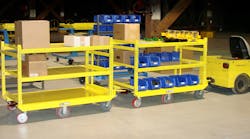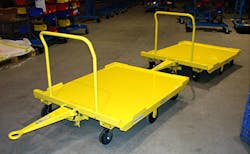Imagine a forklift-free plant floor where unmanned carts deliver parts to an assembly line. It's a scenario that's becoming a reality in at least a few plants throughout North America. Last year, NED mentioned John Deere's plans to introduce automated guided vehicles to deliver parts and materials throughout its Horicon, Wis., plant.
Not every plant has the budget to implement such high-tech, automated solutions. But any technology that can decrease forklift traffic helps plants improve material flow and increase safety, says Jim Galante, director of business development at Southworth Products Corp., a maker of ergonomic material handling equipment.
"Many companies are trying to go forklift free," Galante says. "The reasons for this are fairly significant."
The reason, says Galante, is the number of injuries and fatalities from forklift-related accidents. Powered industrial trucks ranked sixth on OSHA's list of most frequently cited safety and health violations, according to the U.S. Department of Labor. Additionally, a forklift carries one pallet or container at a time, not the most efficient use of driver and equipment.
Check out Southworth's latest equipment on the NED Directory.
Many companies are turning to a variety of towable cart systems to safely deliver parts to workstations more efficiently, Galante says. NED recently caught up with Galante to discuss how advancements in material handling systems are favorably impacting industrial environments.
Many people are aware of the safety issues related to forklift traffic. Can you talk a little more about the productivity challenges companies face?
In some cases, companies have to deliver pallets of material to work stations. Very few companies today are going to let a forklift enter a workstation where people are working. The best they can do in that situation is set the pallet down along the aisle. Now the worker has to get a hand pallet jack or a stacker, and he has to walk over to the aisle and pick up that pallet and bring it into a work station. He also has to place the empty pallet back into at the aisle when he's finished with it. Instead of the worker working, he's moving material, and that's not a good lean principal. Lean is all about eliminating waste, and there's a lot of wasted motion there.
What are some of the more efficient alternatives to forklifts?
We're seeing a lot of companies moving toward towable carts. There can be as many as eight or 10 towable carts in a towable train. Those carts are towed by a number of types of vehicles. It could be a tug with a driver, and that driver has very good visibility because he's driving a small tug that looks like a golf cart without the roof on it. Also, a tug operator does not back up a towable cart unlike a forklift, further enhancing safety. The cart is already on wheels, so the worker at the work station doesn't need a secondary piece of equipment like a hand pallet jack or a stacker to move the cart and position it.
Do carts eliminate the need to return an empty pallet during replenishment?
A towable cart is on wheels, so the worker doesn't waste a lot of time having to move it if he has to move it all. For example, he can position two carts near the line, so when he runs out of material on cart one, cart two can be there at his work station. He can continue to work while the driver of the towable vehicle hooks up and pulls away the empty cart.
Can you describe the different types of carts available for industrial applications?
There's a flat cart that will carry a pallet. There also are carts that have gravity rollers on it. With these, you drive the cart to the work station and press a manual latch so the pallet can roll off the cart on to a conveyor at the work station. It goes directly to the conveyor, so the line worker never has to touch the cart. There are also carts called mother-daughter carts. These carts are about 8 feet long with four wheels and two open areas in the middle, where you can fit another cart. In this scenario, you would pull the towable frame up to a work station with a loaded cart, unlatch it and push the loaded cart into the work station. You would then put the empty cart into the mother-daughter frame and take it away. There are also tow vehicles that are autonomous and drive themselves. These use cameras and sensors that map the building, including all the work stations, aisles and crosswalks. It will take a cart to the work station, the worker unhooks the cart and it drives away. That type of system, as expensive as it is, eliminates a tug driver.
Can you talk a little bit about how tilting and lifting capabilities improve the ergonomics at the work stations?
There are some manufacturers of these carts that build in a lift table or tilt table. The problem is that they're very expensive, and when the cart gets to a work station, it has to be plugged in. And you're towing around an extra burden, which is the weight of the tilter or the lift, which can weigh 300 to 500 lbs. The more practical thing to do is to put a lift or a tilter in the work station and push a cart over it. Now the operator can raise or lower or tilt the container that's on the cart to their ergonomic convenience. This is especially important where a worker along a production line is handling suspension parts for cars or trucks. These parts are very heavy, and if there's a layer of suspension parts on the pallet, the worker not only has to bend over and reach across the pallet, he has to pick up loads that could be 10 to 30 lbs. or more. That's going to take its toll on the worker very quickly, so where there's repetitive motion or heavy loads, tilting or lifting that container becomes very important at the work station.
We also see some of these lifting and tilting devices built with turntables. Ergonomists will tell you that reaching out is actually worse than bending over. In some cases, lifting and tilting isn't as important as rotating, so you may want to rotate the pallet 180 degrees, so you're nearside unloading.
Where does Southworth come into play with lifting, tilting and rotating solutions?
Our applications for Southworth are to lift, tilt and turn in the operation of replenishment or filling the cart. Also, on the production side where the cart needs to be unloaded, we also have a role to lift, tilt or turn to position the cart for the advantage of the operator. Positioning that cart vertically, horizontally or tilting it into position is very important at the unloading point. That's where Southworth shines because we can have a dedicated lift that the cart fits onto or it can latch on to a turntable. In the case of a tilter, the cart is pushed over the tilter, and the tilter is already in the ideal position for the worker. We work closely with the cart manufacturers to not only get the material to the work station but get it to the exact, right position so the worker isn't bending, reaching or stooping, and making the worker efficient at his or her job. These are huge ergonomic improvements and result in productivity gains.
For more information on cart and dolly positioning please visit www.southworthproducts.com/carts.














